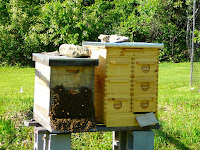
Have I mentioned that a baby bunny died on my watch? That I buried him (I use the male pronoun advisedly, because I thought I espied a tiny leporine penis; most likely as a result of too much exposure to spam offerings of 101 ways to enlarge your member and satisfy your girlfriend.) in the bamboo grove?
 The matter of bunny mortality is just one of the many ways in which I do not resemble Saint Melangell. She (an adamant virgin) fled a suitor’s unwanted advances and resided for fifteen long years alone in the forest, with only the rabbits and hares for companionship. She always protected the bunnies, and they looked after her.
The matter of bunny mortality is just one of the many ways in which I do not resemble Saint Melangell. She (an adamant virgin) fled a suitor’s unwanted advances and resided for fifteen long years alone in the forest, with only the rabbits and hares for companionship. She always protected the bunnies, and they looked after her. If you are wondering which saint I will make reference to when I make a few gracious remarks this evening on the occasion of the rehearsal dinner for Tristram and Nika, you can breathe a sigh a relief that – after some serious vacillation, it must be admitted – I will not mention Saint Theodosia as an example of female strength and leadership. Theodosia lived in 8th century Constantinople. When the Emperor decreed that all Christian images be torn down, Theodosia was the ringleader of a group of defiant woman who shook the ladder supporting the functionary attempting to tear down the image. The man fell and died. (It must have been a very tall ladder.) Then Theodosia and her gang stoned the palace of the pseudo-patriarch.
If you are wondering which saint I will make reference to when I make a few gracious remarks this evening on the occasion of the rehearsal dinner for Tristram and Nika, you can breathe a sigh a relief that – after some serious vacillation, it must be admitted – I will not mention Saint Theodosia as an example of female strength and leadership. Theodosia lived in 8th century Constantinople. When the Emperor decreed that all Christian images be torn down, Theodosia was the ringleader of a group of defiant woman who shook the ladder supporting the functionary attempting to tear down the image. The man fell and died. (It must have been a very tall ladder.) Then Theodosia and her gang stoned the palace of the pseudo-patriarch.I don’t need to add that she was gruesomely martyred soon thereafter. (A ram’s horn was hammered through her neck.) Butler adds, wryly, “It is not difficult to suggest reason why this nun is not found in the Roman Martyrology.”
So as much as I admire Nika’s strength and leadership skills, I will not be comparing her to Theodosia, whose feast is today.
On the other hand, tomorrow, May 30th, is the feast of Joan of Arc, who was burned at the stake in 1431. And I am a great admirer of Joan of Arc.

















